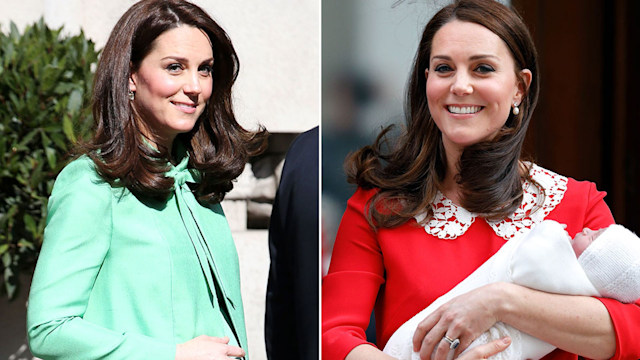Think of hypnobirthing and it may conjure images of a super-chilled earth mum delivering her baby surrounded by petals and chanting 'om', but the calming labour technique is not just an 'airy-fairy' option – far from it. The Duchess of Cambridge is famously a fan!
MORE: Duchess Kate's birth stories revealed: 'I actually really quite liked labour'
HELLO! spoke to qualified Midwife Beth Kitt who delivers babies in an NHS hospital and also runs an online platform called The Bump to Baby Chapter, which focuses on pre-natal and post-natal advice and hypnobirthing classes.
Beth is passionate about helping women have positive birthing experiences and it was fascinating to speak with her. Did you know that you can incorporate simple hypnobirthing techniques into your hospital birth to benefit both mum and baby?
WATCH: Surprising facts about royal babies
The Duchess of Cambridge used hypnobirthing techniques during her labours in hospital, previously telling Giovanna Fletcher on the Happy Mum, Happy Baby podcast:
"I'm not going to say that William was standing there chanting sweet nothings at me! He definitely wasn't, [laughing] I didn't even ask him about it, but it was just something I wanted to do for myself.
"I saw the power of it, really, the meditation and the deep breathing and things like that that they teach you in hypnobirthing when I was really sick and actually I realised that this was something that I could take control of, I suppose, during labour. It was hugely powerful."
Below, Beth Kitt explains what hypnobirthing is, exactly how to practice it and its invaluable uses before and after birth too….
What is hypnobirthing?
Beth tells HELLO!: "I describe hypnobirthing as a type of antenatal education. People often think it's quite air fairy but it's not – I think of it more as changing the way you think about birth.
"When we think of birth, we might think about the opening credits of One Born Every Minute of women lying on a bed. In films we see the pregnant woman's waters break, then it's a rush to hospital then they're lying in bed with their legs in stirrups. Those are the images we have. That's actually far from what the majority of people want their birth to be like.
"So hypnobirthing is about changing the way you look at birth and learning techniques to be able to use in all types of birth situations – that might be to cope with the pain of contractions or to make a choice rather than being told what to do. That can help you feel confident and in control. Then there's breathing techniques, visualisations, massage and your birth environment."
MORE: Postnatal recovery tips: a doula shares her dos and don'ts for new mums
Using hypnobirthing in hospital
"I think hypnobirthing is almost more important when you're on a consultant-led hospital unit because you often feel like you've got to do what the doctor says – you feel like your options are maybe a little more limited," explains Beth.
"Hypnobirthing is all about trying to have a positive birth; trying to stack the odds in your favour for you to get the birth that you want – whether that be that you have your epidural straight away or that you have no pain relief or you want to have an active birth. All of these things can be facilitated on a consultant-led unit."
The birth environment
Beth suggests: "Take your birth environment... you can replicate a really nice birth environment even in a hospital room.
I'd always encourage mums to have the lights down low and use things like essential oils - especially if they've been using the oils throughout their pregnancy. Things like bringing in fairy lights to make the room nicer. You can use a projector to put stars onto the ceiling to create a spa-like room.
"Often women associate those types of births with more midwife-led units but actually, there's no reason why you couldn't have that on a consultant-led unit. Even if you need continuous monitoring during your labour, many hospitals have wireless monitors now so you can still have a water birth or use a birth ball with these."
Breathing techniques
Beth advises: "With your breath, the longer your out-breath, your parasympathetic nerve is going to be kick-started. This reduces your heart rate, makes you feel calmer and increases your oxytocin, which is the hormone that gives you contractions. It increases your endorphins as well, which is your body's natural pain relief.
"I always say to breathe in for four seconds through your nose and then out for seven through your mouth. Having this longer out-breath means that your contractions are going to be smoother and you won't feel as much pain.
"There's a fear-tension-pain cycle. If you feel fear, you're more likely to feel tension which means you're more likely to feel pain and then you may feel more fear. It goes round and round. Using your breathing techniques reduces the tension part because you're relaxing your body, which is one way of breaking that cycle."
MORE: Why the Queen's childbirth process with Charles, Anne and Andrew is controversial today
Visualisation techniques
Beth says: "Visualisations can be used as a distraction method in labour. With the breath, you can imagine blowing a gold ribbon or picturing the flicker of a candle.
"Some people prefer those types of visuals while others prefer basic counting. I always use exercise as an example, like running for one more minute or exercises in a HIIT class. It's a similar thing.
"A contraction is around a minute long and then you have a break. Often when we think about labour everyone just talks about the pain, like it's a constant pain, and it's not. It's a contraction and then a break. If you can focus on one contraction at a time, then it makes it more manageable."
Using hypnobirthing with a caesarean
"When women have a caesarean they might have different worries such as the spinal going in or something going wrong - that general feeling of fear and anxiety," says Beth. "But you want to be able to switch that feeling off."
"Using breathing techniques, having your partner with you and even things like opening your palms and dropping your shoulders can all help encourage that oxytocin. Oxytocin is just as important a hormone in a caesarean because it helps you bond with your baby afterwards. It's the hormone that will be in your memory when you give birth.
"So for example, if you have high levels of oxytocin, you're more likely going to look back on the birth of your baby as a really memorable, wonderful experience, rather than if it's filled with adrenaline and fear, you might remember the experience as traumatic and scary. I think that's a big deal – you want to look back on your baby's birthday as something lovely to remember.
"With an emergency caesarean, you may have been planning a natural birth, but I still encourage women to see the C-Section as a choice. The doctor may be advising the caesarean to keep your baby safe, but ultimately it's your decision and that should be empowering thing for you. You are making a choice to have your baby in the safest way possible, and that's a strong and brave thing to do. It's still within your control."
Positive thinking before birth
Beth tells us: "Leading up to the birth, women have so many different anxieties and it's not always birth related. It could be to do with the health of the baby, their relationship or money worries. Those thoughts are never helpful in day to day life. It's important to remember to control the things you can and let go of the things you can't.
"To switch off that overthinking part of your mind, use relaxation. Put on a calming audio before bed to help focus your thoughts on something relaxing. Or try birth affirmations. If there is anything you're worried about, use birth affirmations to flip it. If you're worried something awful is going to happen, keep reminding yourself that birth is safe, your baby is safe.
"If you're worried about things going out of control, remind yourself that your partner is there and by your side. It's about focusing on the positives and things you can control."
Staying calm as a new mum
"Post-birth is a testing time because you're trying to recover physically and mentally from your birth but you've also got to care for this little being that's so demanding of you," says Beth.
"It's important to get as much help as you can from the hospital while you're there, do lots of skin to skin which encourages oxytocin and make you feel calmer and it helps you bond with your baby. If you're choosing to breastfeed, it helps with that too.
"Don't put too much pressure on yourself. Some mums feel like they have to look like they've got themselves together for visitors, but actually, we're all just muddling through in the best way possible."
For more information on Hypnobirthing visit thebumptobabychapter.co.uk


